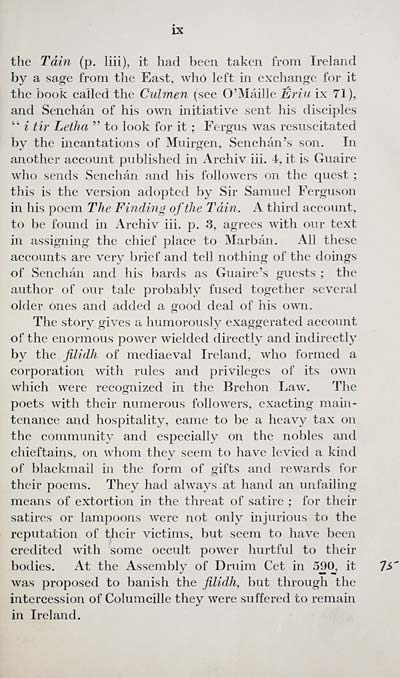Download files
Complete book:
Individual page:
Thumbnail gallery: Grid view | List view

the Tain (p. liii), it had been taken from Ireland
by a sage from the East, who left in exehange for it
the book called the Culmen (see O'Máille Ériu ix 71),
and Senclián of his o^vn initiative sent his disciples
" i tir Letha " to look for it ; Fergus was resuscitated
by the incantations of Muirgen, Senchán's son. In
another account published in Archiv iii. 4, it is Guaire
who sends Senchán and his followers on the quest ;
this is the version adopted by Sir Samuel Ferguson
in his poem The Finding of the Tain. A third account,
to be found in Archiv iii. p. 3, agrees with our text
in assigning the chief place to Marbán. All these
accounts are very brief and tell nothing of the doings
of Senchán and his bards as Guaire's guests ; the
author of our tale probably fused together several
older ones and added a good deal of his own.
The story gives a humorously exaggerated account
of the enormous power wielded directly and indirectly
by the jiUdh of mediaeval Ireland, who formed a
corporation with rules and privileges of its own
which were recognized in the Brehon Law. The
poets with their numerous followers, exacting main-
tenance and hospitality, came to be a heavy tax on
the community and especially on the nobles and
chieftains, on whom they seem to have levied a kind
of blackmail in the form of gifts and rewards for
their poems. They had always at hand an unfailing
means of extortion in the threat of satire ; for their
satires or lampoons were not only injuriovis to the
reputation of their victims, but seem to have been
credited with some occult power hurtful to their
bodies. At the Assembly of Druim Get in 590, it
was proposed to banish the filidh, but through the
intercession of Columcille they were suffered to remain
in Ireland.
by a sage from the East, who left in exehange for it
the book called the Culmen (see O'Máille Ériu ix 71),
and Senclián of his o^vn initiative sent his disciples
" i tir Letha " to look for it ; Fergus was resuscitated
by the incantations of Muirgen, Senchán's son. In
another account published in Archiv iii. 4, it is Guaire
who sends Senchán and his followers on the quest ;
this is the version adopted by Sir Samuel Ferguson
in his poem The Finding of the Tain. A third account,
to be found in Archiv iii. p. 3, agrees with our text
in assigning the chief place to Marbán. All these
accounts are very brief and tell nothing of the doings
of Senchán and his bards as Guaire's guests ; the
author of our tale probably fused together several
older ones and added a good deal of his own.
The story gives a humorously exaggerated account
of the enormous power wielded directly and indirectly
by the jiUdh of mediaeval Ireland, who formed a
corporation with rules and privileges of its own
which were recognized in the Brehon Law. The
poets with their numerous followers, exacting main-
tenance and hospitality, came to be a heavy tax on
the community and especially on the nobles and
chieftains, on whom they seem to have levied a kind
of blackmail in the form of gifts and rewards for
their poems. They had always at hand an unfailing
means of extortion in the threat of satire ; for their
satires or lampoons were not only injuriovis to the
reputation of their victims, but seem to have been
credited with some occult power hurtful to their
bodies. At the Assembly of Druim Get in 590, it
was proposed to banish the filidh, but through the
intercession of Columcille they were suffered to remain
in Ireland.
Set display mode to: Large image | Transcription
Images and transcriptions on this page, including medium image downloads, may be used under the Creative Commons Attribution 4.0 International Licence unless otherwise stated. ![]()
| Early Gaelic Book Collections > Matheson Collection > Tromdámh Guaire > (13) |
|---|
| Permanent URL | https://digital.nls.uk/82339140 |
|---|
| Description | Items from a collection of 170 volumes relating to Gaelic matters. Mainly philological works in the Celtic and some non-Celtic languages. Some books extensively annotated by Angus Matheson, the first Professor of Celtic at Glasgow University. |
|---|
| Description | Selected items from five 'Special and Named Printed Collections'. Includes books in Gaelic and other Celtic languages, works about the Gaels, their languages, literature, culture and history. |
|---|

